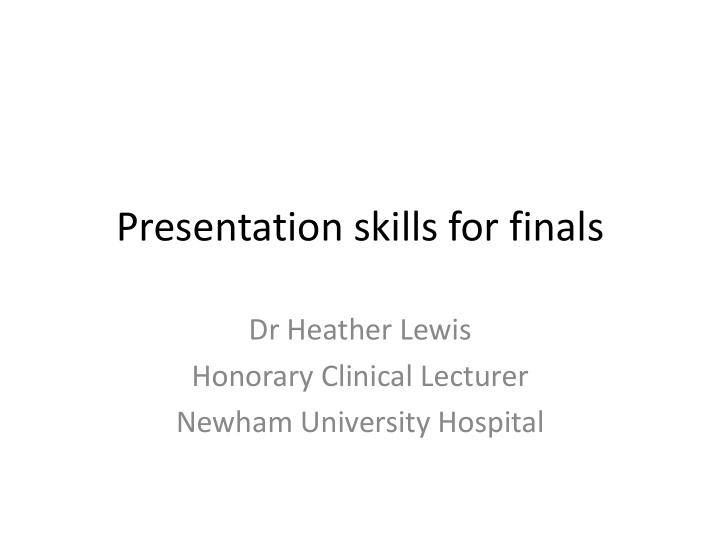



Presentation skills for finals Dr Heather Lewis Honorary Clinical Lecturer Newham University Hospital
Overview • Review of the generic skills needed when presenting • Specific presentation scenarios • Tips and tricks of good presentations
Generic skills • Fluent • Coherent • Succinct
Generic tips for presenting • Be logical – present in the order you examined – then you wont forget anything! • State positive findings and relevant negatives • Always summarise at the end • Know 2 or 3 differentials for common examination findings and how to distinguish them
Starting your presentation • Remove stethoscope • Hold your hands behind your back • Look at the examiners directly (look at their nose if you don’t want to look them in the eye)
To complete my examination I would like to… • Cardiovascular: – “Perform a peripheral vascular exam, fundoscopy and a urine dipstick” • Respiratory: – “Perform a peak expiratory flow measurement, check the oxygen saturations, and examine the sputum” • Gastrointestinal: – “Examine the external genitalia and the hernial orifices and perform a digital rectal examination”
To complete my examination I would like to… • Neurological: – “perform a complete peripheral nervous system examination, a cranial nerve examination and fundoscopy ”
The presentation • Always start with: • “I examined the ……………. system of this .........(age) year old man/ woman” • Present in the sequence you examined in – General inspection – Close inspection – Hands – Face – Palpation – Percussion – Auscultation
Always comment on… • Whether the patient looked well or unwell • Whether the patient was comfortable at rest • Any peripheral paraphernalia of disease around the bed • Any peripheral stigmata of disease on inspection of the patient
The presentation: • Explain the positive findings at each stage and relevant negatives i.e. – Murmer – “no peripheral signs of infective endocarditis or heart failure” – Jaundice “no peripheral stigmata of chronic liver disease, no hepatosplenomegaly and no ascites ” – Wheeze “no evidence of nebulisers/ oxygen, no tar staining, no hyperexpansion of the chest” – Right sided upper limb weakness “no right sided facial droop, normal reflexes, no fixed flexion deformities of the arm”
The presentation • Practice stating your findings in a professional way i.e. – “On auscultation of the anterior chest wall” – Not “when I listened to the front of the chest”
Presenting normal findings • Respiratory: – “Chest expansion was ……cm and equal on both sides” – “The percussion note was resonant throughout both lung fields” – “Breath sounds were normal, and there were no added sounds” – “Vocal resonance was normal”
Presenting normal findings • Cardiovascular: – “The pulse was … beats per minute and regular. The character and volume as assessed at the carotids were normal” – “The apex beat was in the 5 th intercostal space, mid-clavicular line” – “There were no heaves or thrills” – “Auscultation of all four areas of the heart revealed normal heart sounds and no added sounds”
Presenting normal findings • Gastrointestinal: – “Palpation of the abdomen revealed no masses or organomegaly ” – “Percussion of the abdomen was normal” – “Auscultation of the abdomen revealed normal bowel sounds, and there were no hepatic or renal bruits”
Presenting normal findings • Peripheral Neurological System: – “Tone was normal” – “Power was 5/5 on flexion and extension of the hip, knee and ankle” – “Co - ordination was normal” – “Sensation in all lower limb dermatomes was normal to light touch (and pain if tested). There was no evidence of peripheral neuropathy. Vibration sense and proprioception were normal”
Presenting normal findings • Cranial nerves: – “Cranial nerves 1 to 12 were intact”
Completing your presentation • Always end with – “In summary my findings were…….. • List your findings – My differential diagnosis in this case is……. • Your top 3 differential diagnoses
Examples – Aortic stenosis • I examined the cardiovascular system of this 67 year old gentleman • On general inspection the patient appeared well and comfortable at rest • In the hands there were no stigmata of infective endocarditis • The pulse rate was 72 beats per minute and was slow rising in nature • The JVP was not raised • The apex beat was not displaced • On auscultation of the praecordium a loud ejection systolic murmer could be heard in all 4 areas, but was loudest in the aortic area, and radiated to the carotids. • There were no basal crepitations or pedal oedema • In summary this gentleman has an ejection systolic murmer which radiates to the carotids, associated with a slow rising pulse with no evidence of infective endocarditis or heart failure. • These findings are consistent with a diagnosis of aortic stenosis • My differential diagnosis of an ejection systolic murmer would include pulmonary stenosis and hypertrophic obstructive cardiomyopathy
Example - Ascites • I examined the gastrointestinal system of this 44 year old woman • She appeared well and comfortable at rest • There were no peripheral paraphernalia of gastrointestinal disease • On general inspection she was jaundiced and had a distended abdomen • There was no asterixis • She had evidence of chronic liver disease with palmar erythema, spider naevi and caput medusa • Palpation of the abdomen revealed 4cm splenomegaly and no hepatomegaly. There were no masses • There was evidence of shifting dullness on percussion • Auscultation of bowel sounds was normal • In summary this patient has ascites and splenomegaly, in association with palmar erythema, spider naevia and caput medusa • This is consistent with a diagnosis of decompensated chronic liver disease • My differential diagnosis would include Budd Chiari syndrome or malignancy with peritoneal metastases
Any questions?
Recommend
More recommend